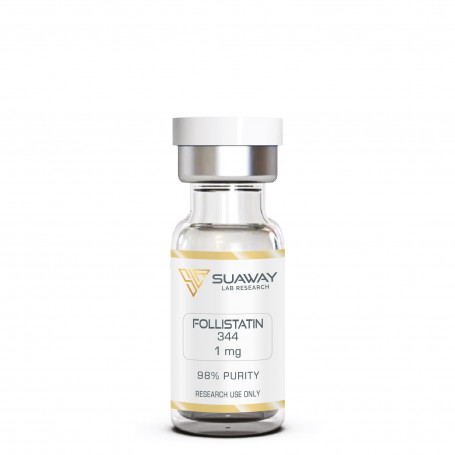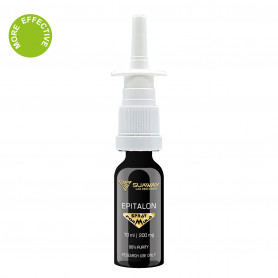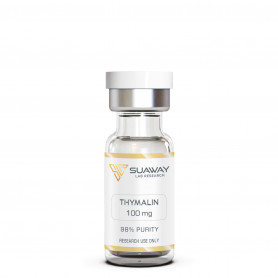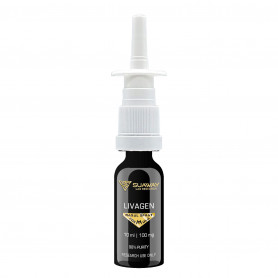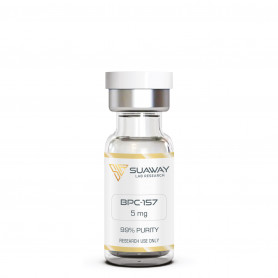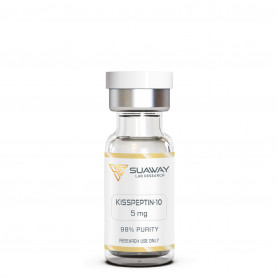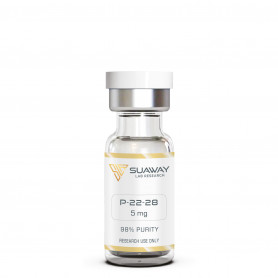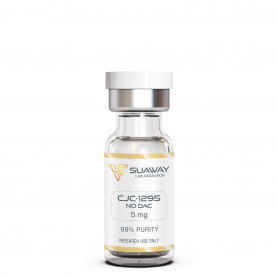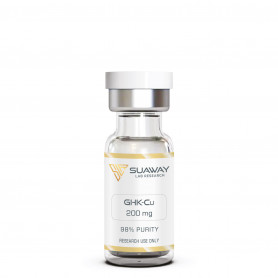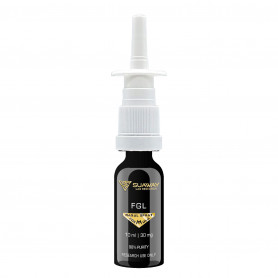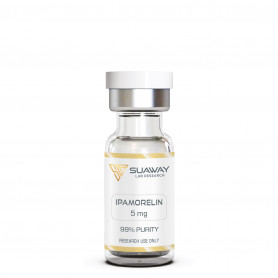FOLLISTATIN-344 - 1 mg
The naturally occurring protein Follistatin has a synthetic equivalent known as Follistatin-344. Myostatin, activin, and the actions of follicle-stimulating hormone are all rendered ineffective as a result (FSH). Studies conducted on animals show that these behaviors result in increased muscle growth (both hypertrophy and hyperplasia), decreased production of scar tissue, and inhibition of specific inflammatory responses.
Beschreibung
STRUCTURE
Sequence: MVRARHQPGG LCLLLLLLCQ FMEDRSAQAG NCWLRQAKNG RCQVLYKTEL SKEECCSTGR LSTSWTEEDV NDNTLFKWMI FNGGAPNCIP CKETCENVDC GPGKKCRMNK KNKPRCVCAP DCSNITWKGP VCGLDGKTYR NECALLKARC KEQPELEVQY QGRCKKTCRD VFCPGSSTCV VDQTNNAYCV TCNRICPEPA SSEQYLCGND GVTYSSACHL RKATCLLGRS IGLAYEGKCI KAKSCEDIQC TGGKKCLWDF KVGRGRCSLC DELCPDSKSD EPVCASDNAT YASECAMKEA ACSSGVLLEV KHSGSCNSIS EDTEEEEEDE DQDYSFPISS ILEW
Molecular Weight: 3780 g/mol
PubChem CID: 178101631
Purity: greater than 98%
No Tfa Salt
Storage: Lyophilized peptide must be stored at -20°C and peptide solution at 4°C.
Follistatin-344 has low oral and excellent subcutaneous bioavailability.
DESCRITPION
The naturally occurring human follistatin protein has been artificially replicated and given the name Follistatin (FST) 344. Neutralization of proteins belonging to the TGF-beta superfamily is the principal biological function that it serves.
Follistatin inhibits the action of many different proteins and hormones such as:
- Activins, which play a role in apoptosis, metabolism, endocrine homeostasis, bone growth, fibrosis inflammation, neurogenesis, tubulogenesis of endothelial cells, and the development of cancer
- Myostatin, is a protein that limits the development of muscle
- GDF-11, is a growth factor that has a role in the formation of bone
- Follicle-stimulating hormone(FSH), sometimes known as FSH, is an important factor in the production of both eggs and sperm (gametes)
Myostatin is a protein that is generated by muscle cells themselves. It prevents new muscle cells from developing and prevents existing muscle cells from differentiating. Because it is a TGF-beta protein, it is sensitive to suppression by follistatin because it is a member of the TGF-beta protein family. Previous studies have shown that animals that are missing the myostatin gene have much more muscle mass and are significantly stronger than average.
It has been shown that follistatin may enhance the amount of lean muscle mass in mice models without the need for any particular dietary or activity needs. After just eight weeks of receiving follistatin injections, mice who were part of the treatment group had 10% greater muscle mass than mice that were part of the control group. In a study conducted on six male patients diagnosed with Becker muscular dystrophy, an ailment of the musculoskeletal system that manifests itself primarily in the lower limbs and pelvis, follistatin injections were shown to increase muscle strength, resulting in an amelioration of the patient's symptoms without the occurrence of any unfavorable side effects.
In addition, increasing follistatin levels has been investigated as a potential therapy for sarcopenia, which is a muscle-wasting illness associated with aging. When given regularly to older mice, the natural substance epicatechin, which elevates levels of the hormone follistatin, led to an increase in the animals' total muscular strength. After a week of receiving the same therapy, six different human participants saw an improvement in their hand grip strength.
It has been shown via research into the effects of follistatin on muscle development that the injection of follistatin at any age may lead to long-term advantages on muscular hypertrophy. This is an intriguing part of the study into the effects of follistatin on muscle growth. In mouse models, the one-time treatment of follistatin through gene therapy resulted in improved mass and strength in both normal and dystrophic animals for more than two years.
According to the findings of recent studies, follistatin promotes increased muscle development by activating the insulin/IGF-1 pathway. It is interesting to note that for the protein to exert its full anabolic impact, the presence of only one of these signaling molecules is sufficient. The fact that follistatin causes the pancreas to generate more insulin lends credence to the hypothesis that the protein is intricately connected to the signaling process that insulin undergoes.
According to studies conducted on mice, excessive expression of follistatin may increase the number of beta-islet cells, which are the cells that are responsible for the production of insulin. This results in a rise in insulin levels, a fall in glucose levels when fasting, and a lessening of the symptoms of diabetes. The most noteworthy finding was that mice given follistatin had their lifespans increase by a factor of two because the problems associated with diabetes were almost removed.
A decrease in the size of fat-storing cells (adipocytes) was seen with a reduction in the amount of fat that was gained when mice had their follistatin levels increased. Follistatin can combat obesity and diabetes by lowering myostatin levels. This might make it an effective agent in both of these battles.
Follistatin also can block the action of activins, which are important for the reproductive system in many different ways. For instance, activins have a role in the development of reproductive organs (such as the testes and the ovaries), and disruptions in the normal function of activins have been linked to the formation of malignancies in those organ. There is a correlation between an increase in the levels of activin found in women and the aging of the reproductive system. In addition to being connected to polycystic ovarian syndrome and difficulties during pregnancy, abnormalities in the activities of follistatin and activin have been studied.
It was discovered that follistatin is over-expressed in a tiny percentage of breast cancer cases, but it is under-expressed in the vast majority of breast cancer cases. When there is an excess of follistatin in the body, cancers develop more quickly but are much less invasive. There is a significant positive correlation between the presence of follistatin and increased survival and a decreased risk of breast cancer metastases. Using a mouse model of HER2-positive breast cancer, researchers were able to demonstrate that follistatin could inhibit the spread of metastases. It was discovered that follistatin prevents activin from causing breast epithelial cells to migrate, however, the protein is absent in the majority of breast tumors. It was discovered that restoring follistatin prevented the creation of lung metastases, although it did not affect the growth of the tumor.
Follistatin has been found to protect the liver against the first stages of fibrosis, which slows the course of liver disease. After receiving follistatin for four weeks, fibrosis was reduced in rats by 32 percent, according to research conducted on these animals.
According to studies conducted on people, follistatin seems to be capable of significantly boosting hair development, especially when used in conjunction with other products that stimulate hair growth. The results of a limited experiment consisting of just 26 people indicated a roughly 13% rise in overall thickness and a 20% increase in hair density. Following therapy with a single intradermal injection of a follistatin/Wnt- combination, these findings persisted for at least a year.
REFERENCES
H. Gilson et al., "Follistatin induces muscle hypertrophy through satellite cell proliferation and inhibition of both myostatin and activin" [PubMed]
L.R. Rodino-Klapac et al., "Inhibition of myostatin with emphasis on follistatin as a therapy for muscle disease" [PubMed]
S. Muttukrishna et al., "Serum activin A and follistatin in disorders of spermatogenesis in men" [PubMed]
R. Wijayarathna et al., "Activins in reproductive biology and beyond" [PubMed]
J. Kota et al., "Follistatin gene delivery enhances muscle growth and strength in nonhuman primates" [PubMed]
L. Grobet et al., "Modulating skeletal muscle mass by postnatal, muscle-specific inactivation of the myostatin gene" [PubMed]
R.A. Anderson et al., "Follistatin and activin A production by the male reproductive tract" [PubMed]
Se-Jin Lee et al., "Regulation of Muscle Mass by Follistatin and Activins" [Molecular Endocrinology]
A. Iskenderian et al., "Myostatin and activin blockade by engineered follistatin results in hypertrophy and improves dystrophic pathology in mdx mouse more than myostatin blockade alone" [PubMed]
T.K. Woodruff et al., "Activin A and follistatin are dynamically regulated during human pregnancy" [PubMed]
M.W. Hamrick et al., "Resistance to body fat gain in 'double-muscled' mice fed a high-fat diet" [PubMed]
J. Hansen et al., "Exercise induces a marked increase in plasma follistatin: evidence that follistatin is a contraction-induced hepatokine" [PubMed]
M. Nakatani et al., "Follistatin-derived peptide expression in muscle decreases adipose tissue mass and prevents hepatic steatosis" [PubMed]
M. Sharp et al., "The effects of a myostatin inhibitor on lean body mass, strength, and power in resistance trained males" [PubMed]
C. Barbé et al., "Role of IGF-I in follistatin-induced skeletal muscle hypertrophy" [PubMed]
C. Zabkiewicz et al., "Increased Expression of Follistatin in Breast Cancer Reduces Invasiveness and Clinically Correlates with Better Survival" [PubMed]
D.D. Seachrist et al., "Follistatin is a metastasis suppressor in a mouse model of HER2-positive breast cancer" [BMC]
L. Shi et al., "Clinical and Therapeutic Implications of Follistatin in Solid Tumours" [PubMed]
C. Zhao et al., "Overcoming Insulin Insufficiency by Forced Follistatin Expression in β-cells of db/db Mice" [PubMed]
DISCLAIMER
This product is intendend for lab research and development use only. These studies are performed outside of the body. This product is not medicines or drugs and has not been approved by the FDA or EMA to prevent, treat or cure any medical condition, ailment or disease. Bodily introduction of any kind into humans or animals is strictly forbidden by law. This product should only be handled by licensed, qualified professionals.
All product information provided on this website is for informational and educational purposes only.

